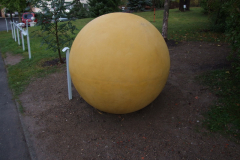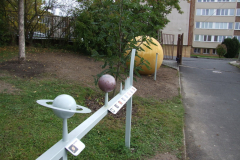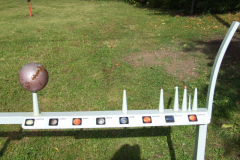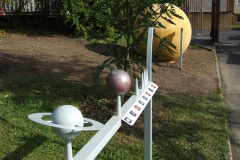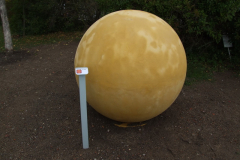
Saturn’s rings. Source: http://edu.glogster.com/media/13/39/93/53/39935305.jpg
A schematic model of the bodies has been created at a scale of 1: 1 billion
(1 : 1, 000, 000, 000, respectively 1 : 109). This proportion corresponds to the size of solid models representing the sun and other bodies of our solar system (shown are the eight major planets – Mercury, Venus, Earth with the Moon, Mars, Jupiter, Saturn, Uranus, and Neptune, the largest asteroid, Ceres, Halley’s Comet, and three dwarf planets – Pluto, Eris, and Sedna).
1,000 km (1, 000, 000 m) in fact corresponds to 1 mm in the model.
1 m model corresponds to 1 million miles in reality.
1 AU (≈ 150 million km ≈ 500 light seconds) in fact corresponds to about150 m in the model.
Since the relative distances of objects in the chosen scale of 1: 109 are so great that the body can not be placed in the campus area (such as the Earth on this scale would have to be located 150 m from the model of the Sun, Jupiter would orbit at a distance of 780 m and Neptune 4.5 km), a thousand times smaller scale of 1: 1 trillion
was used to place the Sun satellites models.
Calculations:
http://www.exploratorium.edu/ronh/solar_system/index.html

Source:
http://upload.wikimedia.org/wikipedia/commons/9/90/NovaSlunecniSoustava.jpg
Solar System (SS)
is a grouping of many bodies – both large and dwarf planets, asteroids (asteroids), comets, countless meteroids, dust and gas, but also artificial satellites and space probes, bound by gravity to the Sun.
Bodies orbit around the sun, and on elliptical trajectories in the direction of rotation. From the perspective of the constellation Draco (ie from the North ecliptic pole) it is a direct move counterclockwise. the Sun and, most planets rotate on their axis in the same direction. Also, most moons orbit their planet in a straight line. Direct movement of most bodies in the solar system is a legacy of the rotating motion of the pre-solar nebula from which the entire solar system was created some four and a half billion years ago.
In space, the sun system is arranged into four basic parts:
(1) In the very center there is the Sun. It is a basic source of light and heat, and it concentrates the bulk of the weight (99.85%) of the entire SS.

Source:
http://planets.cz/wp-content/galerie/slunce/slunce14.jpg
(2) The Planetary system, comprising eight planets, whose paths are approximately in one plane. (For large eccentricity and inclination of the track, as well as relatively low weight, Pluto is not classed as planet any more.) The planetary system extends to a distance of about 50 AU and has a concentrated around one thousandth of the total weight of the SS.
Astronomical Unit (English astronomical unit, symbol AU) is a unit of length, used especially for measuring distances in the SS. It is equal to the mean Earth-Sun distance, ie, orbicular 150 million kilometers.
(3) Kuiper Belt of comets, centaurs and dwarf planets. It is flattened to an ecliptic encircling the edge of the planetary system to the distance of about 1000 AU. Out of it, short-periodic comets get into interplanetary space. The planetary system surrounded by the Kuiper Belt forms the flattened inside of the solar system.

Kuiper Belt Source: http://www.absoluteaxarquia.com/nightsky/images/kuiper_belt.gif

(4) Oort cloud comets are spherical outer solar system package. It extends to a distance of about 120 000 AU (2 ly) from the Sun. In its outer part it moves into the surrounding interstellar space and is influenced by nearby stars. It is a reservoir of hundreds of billions of comets, from where long-period comets come. All of the Oort cloud comets together account for about one millionth of the total weight of the SS
Light year (symbol ly) is a synoptic unit of distance in space. A light year is not a unit of time. It is used to express distances in astronomy, it is the distance at that light travels in vacuum (at a rate of about 300, 000 km / sec) in one year, ie 63, 240 AU ≈ 9.46 × 1015 mm. The distance figure, expressed in light years, indicates the time that a beam of light needs to reach us on the way from a cosmic object. Professional literature prefers a slightly larger unit, parsec (pc). 1 pc ≈ 3.26 ly, ly 1 ≈ 0.306 pc.
The spatial size of the SS is determined by the mass of the Sun: its gravity extends to the outer border of the Oort cloud. Behind it there is the interstellar space where the gravitational forces are temporarily applied by passing stars.
The Solar System is a member of a large galaxy star system. It is in the inner part of Orion’s shoulders, 30 000 ly away from the galactic center. Together with the surrounding stars, it moves as a result of galactic rotation toward the Cygnus constellation at 230 km / s-1. Due to the surrounding stars it is moving at a distance of 19.4 km / sec toward the apex in the Hercules constellation.
Halley’s Comet


Zdroj: http://www.company7.com/c7news/graphics/lspn_comet_halley1200833.jpg
Zdroj: http://csep10.phys.utk.edu/astr161/lect/comets/halley.html
is a short-periodic one with a circulation of 75.3 years. The furthest on its journey it gets in the aphelium, which is located beyond the orbit of the Neptune at a distance of 35.1 AU (5.25 billion kilometers). Here it is a dead body with no apparent activity.
Most beautiful as the comet emerges is its tail. It has to do with steadily growing convergence to the Sun, where the comet surface (due to increasing temperature) literally torments, spewing into space a large amount of dust and gas that is formed by the solar wind and solar radiation pressure into an up to several hundred million miles long tail. After the flyby at the Sun’s closest approach in the perihelion (0.586 AU at Halley = 87.5 million kilometers), the comet will go back into the distant ends of the solar system. This scenario with other time data and distances, of course, applies to all comets.

Source: http://cs.wikipedia.org/wiki/Soubor:Cometorbit.sk.png
Trans-Neptunian Objects
(TNO = Trans-Neptunian Objects)
The belt of objects beyond the orbit of Neptune is probably the least explored region in the solar system. Leaving aside Pluto, the first TNO was discovered about ten years ago, in August 1992.
Since that time, almost five hundred thousand of these bodies have been discovered. Tracks of around forty percent of them are known well, and we even know further physical characteristics of several dozen of those. Depending on their orbits, these bodies can be divided into three major groups:
- Classic Trans-Neptunian Objects
- Kuiper belt objects (KBO) are objects at distances of 30 (near the orbit of Neptune) to 50 AU, including for example the so called
- Plutinos (named after the dwarf planet Pluto with moonCharon, which is their first discovered representative). The asteroid of Eris (formerly known under the provisional name of Xena by the main character of the same TV series) ranks among plutinos as well.
- Scattered disc objects (SDO), place of origin of most of the observed periodic comets
• Oort cloud objects, such as
Sedna
Note: At the time of its discovery (2003) it was the largest object found in the solar system since Pluto’s discovery in 1930. Currently is the fifth largest known TNO (after Eris, Pluto, Makemake and Haumea).
Source: http://www.ian.cz/detart_fr.php?id=482, http://cs.wikipedia.org/wiki/Transneptunick%C3%A9_t%C4%9Bleso

Source: http://apod.nasa.gov/apod/image/1108/vestaPIA14327.jpg
(The stereo anaglyph was created by combining two different images shot from the Dawn spacecraft; resolution about 500 meters per pixel. After the survey of Vesta, thespacecraft with ion propulsion joined its way to the largest asteroid Ceres main belt.)
Stereoscopic 3D view of the asteroid Vesta
Put on your red-blue glasses and float next to asteroid Vesta. Vesta is a world with a diameter of about 500 kilometers and is located in the main asteroid belt between Mars and Jupiter. The 3D view shows the newly discovered terrain of Vesta, including longequatorial ridges and valleys and a significant three chains of craters at the top right called Snowman. The 3D view also strongly shows the steep walls of many craters, which show bands of light and dark material.
| Ord. no | name of object | actual location (to the central object) | Location in Sun model scale | location in IPEP scale(Illustrated from the edge of the sun) | average of actual diameter | average of diameter in model scale | note |
| 1 | Sun | early onset | early onset | 1,91,020 km | 139 cm | approx. 1,4 m | |
| 2 | Mercury | 57,900,000 km (2.766 AU) | 58 m | 5.8 cm | 4,880 km | 4.9 mm | approx. 5 mm |
| 3 | Venus | 108,200,000 km (0.723 AU) | 108 m | 10.8 cm | 12,104 km | 12.1 mm | approx. 12 mm |
| 4 | Earth | 149,600,000 km (1 AU) | 150 m | 15 cm | 12,756 km | 12.8 mm | approx. 13 mm |
| 5 | Moon | 384,400 km | 0.384 m (38.4 cm) | 0.0384 cm (0.4 mm) 386 mm (38.6 cm) | 3,476 km (0.2725 DZ) | 3.5 mm | |
| 6 | Mars | 227,900,000 km (1.524 AU) | 228 m | 22.8 cm | 6,792 km | 6.8 mm | approx. 7 mm |
| 7 | Ceres | 413,800,000 km (2.766 AU) | 414 m | 41.4 cm | 974 kmequatorial | 0.9 mm | approx. 1 mm |
| 8 | Jupiter | 778,300,000 km (5.203 AU) | 780 m | 78 cm = 0.78 m | equatorial142,984 km (11.2 DZ) | 14.3 cm | approx. 14 cm (139,822 kilometers (average – diameter of the sphere with the same volume as Jupiter) |
| 9 | Io | 421,600 km | 0.422 m | 0.042 cm (0.4 mm) 42 cm | 3,632 km | 3.6 | the so called Galilean moons of Jupiter (the central body is the planet Jupiter) |
| 10 | Europa | 670,900 km | 0.671 m | 0.067 cm (0.7 mm) 67 cm | 3,138 km | 3.1 | |
| 11 | Ganymede | 1,070,000 km | 1,070 m | 0.11 cm (1.1 mm)110 cm | 5,262 km | 5.3 | |
| 12 | Calisto | 1,883,000 km | 1.883 m | 0,19 cm (1.9 mm)190 cm | 4,806 km | 4.8 | |
| 13 | Saturn | 1,427 million km (9,54 AU) | 1.4 km = 1,400 m | 140 cm = 1.4 m | equatorial120,523 km (9.45 DZ) | 12.1 cm | average radius of 116464 km |
| 14 | Halley | perihelion distance 0.587 AU (87,8 million km) aphelion distance 35.1 AU (5,250 million km)major axis 17.9 AU | perihelion 89 m major axis 2.7 kmaphelion 5.25 km = 5,250 m | perihelion89 cm major axis 2.7 maphelion5.25 m | core 16 x 8 x 8 km (median 11 km) tail (more than) 100 milion km | core 0.016 mm coma 10-100 cmtail 100 m | place core under a magnifying glass; (plasma tail has a slight density of about 10 molecules/cm3) |
| 15 | Uranus | 2,870 million km (19.2 AU) | 2.9 km = 2,900 m | 290 cm = 2.9 m | equatorial51,118 km (4.01 DZ) | 5.1 cm | large moons Ariel (581 km), Umbriel (1,170 km), Titania (1,580 km), Oberon (1,520 km), Miranda (240 km) |
| 16 | Neptune | 4,497 million km (30.1 AU) | 4.5 km = 4,500 m | 450 cm = 4.5 m | equatorial49,532 km (3.88 DZ) | 5 cm | |
| 17 | Pluto | 5,900 million km (39.3 AU) | 5.9 km = 5,900 m | 590 cm = 5.9 m | 2,300 km (0.18 DZ) | 2.3 mm | so-called plutoid perihelion30 AU; aphelion 49 AU |
| 18 | Charon | 19,500 km | 1,200 km (0.092 DZ) | 1.2 mm | double-planet | ||
| 19 | Eris (Xena) | 10,130million km (67.7 AU) | 10.1 km = 10,100 m | 10.1 m | estimate of2,400 km (0.19 DZ) | 2.4 mm | so-called plutoid of a family called TNO (Trans-Neptunian Objects) – object in our solar system that moves beyond the orbit of Neptune. |
| 20 | Sedna | 75,000million km(cca 500 AU) | 75 km = 75,000 m | 75 m | estimate of1,200–1,600 km | 1.4 mm | cca 1,400 km (0.11 DZ) |
| 21 | Kuiper belt | 30 AU – 50 AU | 6 km | 6 m | – | – | |
| 22 | Oort cloud | 50,000 AU (3,000 AU – 120,000 AU) | 7,500 km | 7.5 km | – | – |


Source: http://www.astro.cz/apod/ap100104.html
The core of Halley’s Comet
Cometary nuclei, which originated from the initial embryonic material of the solar system, are known to resemble dirty glaciers. The image from the Giotto camera, part of European spacecraft Giotto (1986), shows the potato core that measures about 15 kilometers. On the right side of the core surface there are some visible dark features, while on the left there is gas and dust flowing into the coma. Halley’s comet returns back into the inner solar system once every 76 years, and the nucleus sheds an about six-meter-thick layer of ice and rock into space. These discarded debris from Halley’s nucleus will eventually disperse along the orbits of annual meteorite showers, the October Orionids and Eta Aquarids in May.


Comet – Small size body orbiting the sun most of the elongated elliptical orbit with a period of several up to thousands of years. While approaching the Sun, part of the core material evaporates, and the comet creates a coma and possibly tail. It is the remains of material from the time of the creation of the solar system. Today, it is located in the Oort cloud outside the solar system, at a distance of 20 000 to 100 000 AU. Some comets come from the nearer situated Kuiper belt too.
Oort cloud – sometimes called the Oort Öpik-cloud as well . It is a kind of reservoir of cometary nuclei, which is located some 20 000 100 000 AU from the Sun. It contains a large number of objects with irregular orbits of inclinations between 0 ° ÷ 90 °. They are mostly conglomerates of frozen gases, water ice and rocky debris that come close to the sun due to gravitational disturbances. Their number is estimated at a trillion at a total weight of up to 10 MZ.

